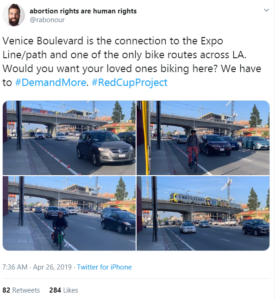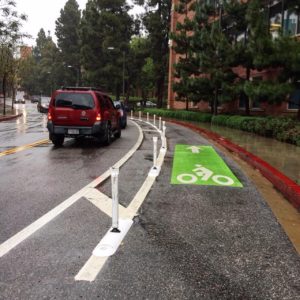Bike Week 2019: Los Angeles Cyclists Dream of Protected Bike Lanes

These are heady days for the soon-to-be-expanded class of Los Angeles commuters who use bicycles (1 percent and growing!) and other non-car modes to navigate our asphalt arcadia.
The breathlessness might come from inhaling small particulate and ozone pollution from car exhaust, or it could have to do with new city and county-level goals to rapidly expand the share of trips taken by bike, foot, rail, and e-mobility devices: the scooters and their smartphone-enabled competitors.
But achieving a multi-modal vision will require infrastructure improvements and public engagement by city leaders to reverse Angelenos’ all-too-correct assumption that cycling is not particularly safe.
Let’s take a look at the targets:
If Los Angeles reaches its new citywide mobility target, in the next seven years, the average Angeleno leaving their house will, one out of three times, leave the car keys on the hook. In the same timeframe, the city has committed to eliminating traffic deaths on Los Angeles’ streets by 2050.
Mayor Garcetti’s Green New Deal plan, with a goal of increasing the percentage of all trips made by walking, biking, and micro-mobility to 35 percent by 2025 and 50 percent from 2035 onward, closer to current bike, walk, and transit mode share in older U.S. cities with dense downtowns, like New York, Washington, Chicago, and San Francisco. At the county level, planners are also prioritizing alternatives to single-vehicle travel in a wider region with more rural areas and encompassing 87 other cities. Los Angeles County’s new draft sustainability plan aims for 15 percent of all trips by foot, bike, micromobility, or public transit by 2025, and 30 percent by 2050.
For our climate, the stakes are high: more greenhouse gas pollution comes from transportation than any other sector in the California economy, with single-passenger vehicles accounting for the lion’s share of emissions.
Despite Los Angeles’ size, the new target might be more achievable than first thought. Angelenos today take 84 percent of trips by car, but half of those trips are under 3 miles in distance. Los Angeles is taking high-profile steps to improve rail (see LA Metro’s Twenty-Eight by ‘28 Plan) and overhaul our bus system (see NextGen Bus Study). But the city is still not making fast enough progress to improve infrastructure that makes our streets safe for pedestrians, cyclists, and other non-car travelers.

In a recent campaign following the death of a Washington, D.C. bicycle activist in a traffic collision, advocates for safe streets across the country placed red plastic cups on painted cycle lanes next to auto traffic. You can guess how long it took for the cups to remain in place on Venice Boulevard, close to the Expo Line station, where vehicle speeds often exceed 30 mph, increasing the chances of a fatal accident.
Many city-designated “bike routes,” including my own commute to UCLA along Ohio Avenue under the 405 Freeway include intermittent painted bike lanes, potholes, faded sharrows (now known to make roads more dangerous for cyclists), and narrow gaps for cyclists to thread between parked vehicles and a slow-moving line of Westside drivers inching along.

Road infrastructure like protected bike lanes and traffic calming measures are essential for Angelenos to envision safe, non-car journeys. In Downtown Los Angeles, the city’s first two-way bike lane opened on Spring Street last month. More lanes with full protection, not just paint, are needed, and their installation can be temporary, experimental, and cheap.
Where the city has recently installed safety infrastructure, such as along a 0.8 mile stretch of Venice Boulevard in Mar Vista, data show traffic collisions decreased and more pedestrians, scooters and bicyclists used the street (interestingly, bicyclist counts declined slightly) with rush hour drive times only increasing by thirty seconds.

Deeper in Los Angeles’ Green New Deal plan is a call for a massive advocacy campaign, by 2021, to encourage shared, sustainable mobility choices. It’s an essential idea. When heated public opposition to new road design and protected bike paths installed in summer 2017 in Playa Del Rey led to a total reversal on the project, city leaders pointed to a too-brief window of public engagement as a major contributor to the backlash.
But better consultation processes and marketing will only be persuasive when coupled with a clear, near-term plan for infrastructure improvements that make non-car journeys safe for commuters of all stripes, young, old, on bikes or rollerblades, on Los Angeles’ far-too-dangerous streets.







Reader Comments